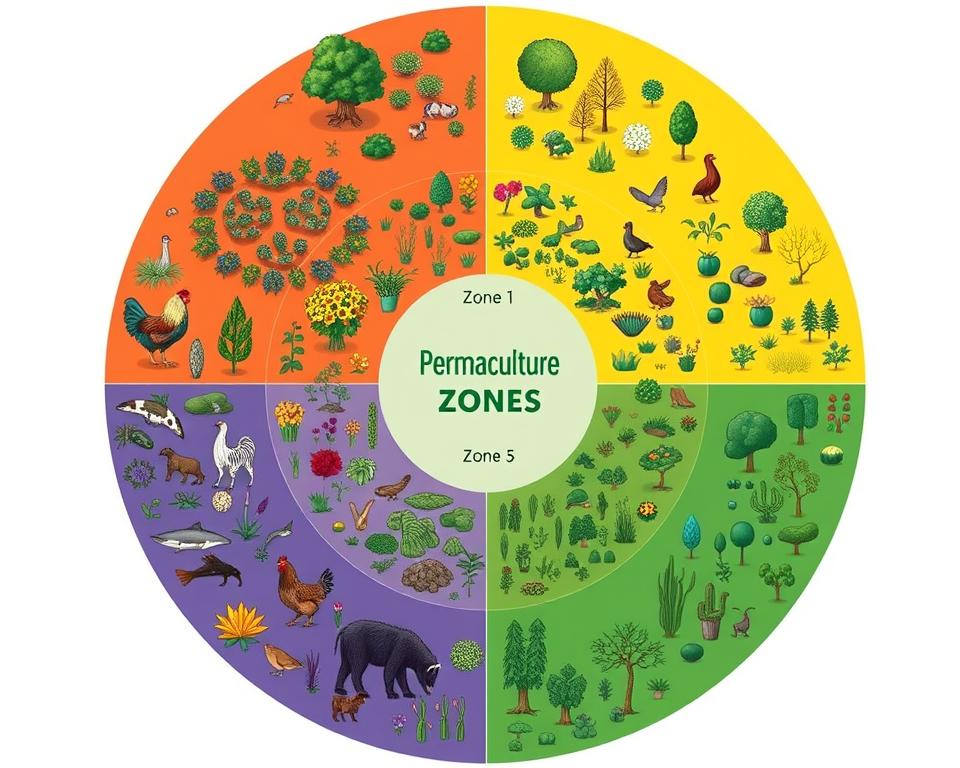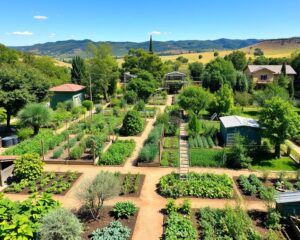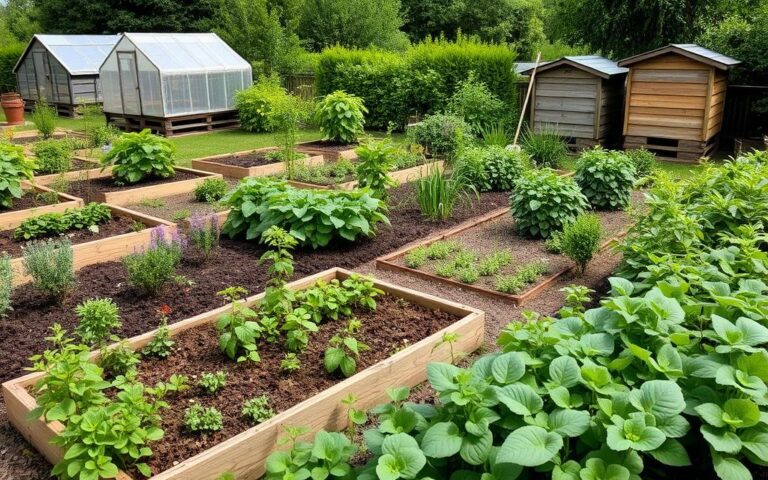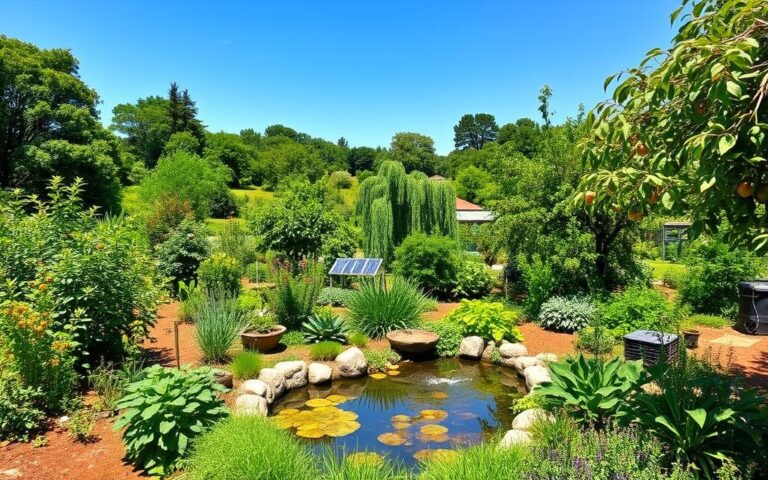Did you know about 30,000 farmers worldwide are using new farming methods? They do this to support their families through organic farming. This shows a big change in how we farm, especially when many Americans still question the need for caring for the environment.
Permaculture started in the late 1970s in Australia by Bill Mollison and David Holmgren. It’s a way to create sustainable ecosystems. It uses nature’s ways to design, aiming for farming that’s good for the planet and productive.
Permaculture focuses on using nature’s resources. It helps people, plants, and animals live together well. This is different from old farming ways.
Permaculture teaches us to improve soil, manage water, and grow many plants. These steps help communities grow strong and safe, even when facing tough environmental times. This article will dive into permaculture’s main ideas, how-to’s, and values. It aims to help you start your own journey toward a sustainable future.
What is Permaculture Design?
Permaculture design is a way to create sustainable ecosystems that work with nature. It uses ecological design principles to make farming more resilient and sustainable. By applying these principles, you can make landscapes that meet human needs and protect the environment.
Defining Permaculture Principles
At the heart of permaculture design are ethical guidelines and key principles. These include:
- Observing and interacting with the natural environment
- Connecting and integrating various components within the landscape
- Catching and storing energy and resources for maximum efficiency
These ideas help create systems that mirror natural ecosystems. They reduce the need for outside help and promote biological diversity.
History of Permaculture
The term “permaculture” was first used in the 1970s in Australia. It combines “permanent” and “agriculture” to describe sustainable farming systems. Over time, permaculture has grown to include methods for sustainable living.
Certified permaculture designers complete a 72-hour course. This course teaches them how to innovate and apply sustainable practices in their communities.
Importance in Sustainable Practices
Permaculture design is crucial for sustainable practices. It transforms traditional farming into regenerative systems. This approach boosts biodiversity, saves resources, and builds resilient communities.
Places like the OAEC campus are examples of permaculture in action. They show how design certifications can improve community well-being. By adopting these principles, we can create a more sustainable future for all.
Core Principles of Permaculture
Learning about permaculture’s core principles is key to creating a sustainable world. These principles help us design systems that work with nature. They make our environment more energy-efficient and reduce waste.
These ideas inspire people and communities to live more ecologically. They guide us in making choices that are good for our planet.
Observe and Interact
Spending time observing and interacting with nature helps us design better. It lets us see how nature works and how things are connected. This understanding helps us make better choices for our environment.
Catch and Store Energy
This principle is about using renewable resources wisely. It’s about capturing and storing energy from the sun and rain. This way, we use energy efficiently and make our systems more sustainable.
Produce No Waste
Permaculture teaches us to reduce waste by using everything we can. It’s about finding new uses for materials instead of throwing them away. This approach helps our ecosystem grow stronger and healthier.
| Principle | Description |
|---|---|
| Observe and Interact | Understanding natural systems through careful observation to create effective designs. |
| Catch and Store Energy | Utilizing renewable resources and maximizing energy efficiency through storage systems. |
| Produce No Waste | Transforming waste into resources by promoting a closed-loop system in design. |
The Ethics of Permaculture
Understanding permaculture ethics is key for those who care about sustainability and the environment. At its heart, permaculture teaches us to create systems that help both nature and people. These principles help build strong communities and promote a green lifestyle.
Care for the Earth
This principle is all about protecting our planet’s ecosystems. It’s about keeping the earth healthy so it can keep supporting life. Following this ethic means using methods that improve soil, keep species diverse, and use land wisely.
Care for People
This ethic is about making sure everyone is well. It says that meeting basic needs is crucial. It encourages community support and self-sufficiency, ensuring everyone gets what they need to thrive.
Share the Surplus
The last principle is about sharing what you have with others. It promotes cooperation and fights against inequality. Sharing not only meets immediate needs but also strengthens the community, making it more resilient against hard times. By living these ethics, we help create a better future for both people and the planet.
Systems Thinking in Permaculture
Permaculture design is all about understanding how things connect in nature. It helps us build sustainable places that work like nature does. By seeing how different parts work together, we can make our designs more diverse and sustainable.
Understanding Ecosystems
In permaculture, knowing how complex ecosystems work is key. Every ecosystem is a web of life where everything interacts. This knowledge helps us see what’s strong and weak in our designs, making them better.
Interconnections Between Elements
Every part of your permaculture design should help each other out. This teamwork cuts down on waste and boosts productivity. For example, plants can protect soil, save water, or attract good bugs. Seeing how these parts work together helps us make our designs more effective.
Feedback Loops in Design
Feedback loops are important for learning and growing in permaculture. By watching how our designs do, we can make them better over time. This way, we not only get more out of our systems but also make them more sustainable.
| Key Concepts | Description |
|---|---|
| Systems Thinking | Understanding and designing for the relationships within ecosystems. |
| Ecological Interconnections | Creating beneficial relationships between plants, animals, and the environment. |
| Feedback Loops | Using outcomes to adapt and improve designs for sustained productivity. |
| Permaculture Design | Integrating ecological principles to create sustainable human settlements. |
Designing Your Permaculture Garden
Creating a thriving permaculture garden is a detailed process. It involves many elements, like choosing the right site and ensuring soil health. Plant diversity is also key. Understanding these elements helps you design a sustainable and productive garden.
Selecting the Right Site
Choosing the right site is the first step. Look at sunlight, topography, and ecosystems. These factors affect water drainage and airflow. Knowing your local climate helps you pick the best plants.
Use Yeoman’s Scales of Permanence to guide your design. This helps make your garden more resilient.
Assessing Soil and Water
Soil health is crucial for a permaculture garden. Test your soil to know its nutrient levels and organic matter. Composting turns waste into valuable nutrients.
Managing water is also important. Rainwater harvesting and mulching help keep your garden moist.
Choosing Plants for Diversity
Plant diversity is key for a strong ecosystem. A variety of plants attracts beneficial insects and reduces pests. Native species fit well with the local environment.
Choose a mix of flowers, herbs, and vegetables. This encourages biodiversity. Plants that attract pollinators also help fertilize your crops, boosting productivity.
| Element | Importance | Practical Application |
|---|---|---|
| Site Selection | Affects sunlight, drainage, and air circulation | Observe and evaluate your landscape |
| Soil Health | Foundation for plant growth and nutrient absorption | Regular soil testing and composting practices |
| Plant Diversity | Enhances resilience and minimizes pest problems | Incorporate a variety of native plants and crops |
Zones and Sectors in Permaculture
Learning about permaculture zones and sector analysis makes your garden better. Each zone has its own role, fitting your design and space needs. Good design comes from understanding these zones and sectors well.
Understanding Zones 1-5
Permaculture zones group things by how close they are to people. Zone 0 is your home. Zones 1 to 5 go from very managed to wild. Here’s a quick look at each zone:
| Zone | Description |
|---|---|
| 0 | Your home, the center for living and management. |
| 1 | Near the house, featuring kitchen gardens and small fruit trees. |
| 2 | Contains larger elements like compost bins and chicken enclosures. |
| 3 | Farmland with main crops, orchards, and pasture. |
| 4 | Managed woodlands or semi-wild areas for resources. |
| 5 | A wilderness area for observation of natural ecosystems. |
Analyzing Sectors
Sectors in permaculture are about outside forces like weather and people. Good sector analysis helps place plants and design gardens better. Think about these when planning your garden:
- Wind patterns that may affect plant growth and exposure.
- Water flow and drainage that influence soil moisture levels.
- Solar gain and shade that determine optimal plant placement.
- Community resources and potential support networks.
Effective Placement in Design
Good design means placing things right to work well together. By using zones and sector analysis, your garden gets better energy flow. This way, you save work and get more from your garden, even in tough weather.

Techniques and Tools for Permaculture
Learning about effective techniques and tools is key for a thriving permaculture garden. Companion planting is a great method that boosts plant interactions. It also improves soil health and controls pests naturally. By using organic methods, you create a sustainable garden ecosystem.
Companion Planting
Companion planting pairs plants for mutual benefits. It saves space and boosts nutrient uptake. For instance, marigolds can repel pests, helping with organic pest control.
Mulching for Healthier Soil
Mulching is crucial in permaculture. It adds organic material to the soil surface. This keeps moisture in, controls temperature, and fights weeds. Mulching makes your garden healthier, helping plants grow well.
Using Natural Pest Solutions
Organic pest control uses natural methods to manage pests. Introducing beneficial insects like ladybugs and lacewings helps. Homemade sprays from natural ingredients also keep pests away.
| Technique | Benefits | Examples |
|---|---|---|
| Companion Planting | Enhances nutrient uptake, pest resistance | Marigolds with tomatoes |
| Mulching | Conserves moisture, suppresses weeds | Straw, grass clippings |
| Natural Pest Solutions | Sustainable pest management | Beneficial insects, homemade sprays |
Using these techniques and tools makes your permaculture garden productive and sustainable. Your dedication to practices like companion planting and organic pest control is crucial. It greatly impacts your gardening journey.
Community and Permaculture
Building a strong permaculture community needs everyone’s help and connection. This community helps share knowledge, resources, and support. It makes permaculture better and helps local projects grow.
Building Supportive Networks
Supportive networks in permaculture help everyone move forward. People share their stories, lessons, and challenges. This sharing leads to new ideas and ways to live sustainably.
You can find local events, workshops, or meetups. These places help build strong relationships and encourage teamwork.
Collaborating on Local Projects
Working on local projects is key for community growth. Projects like community gardens or tree planting bring people together. They help everyone learn and grow.
These projects make communities more inclusive. They bring different voices together, helping everyone contribute to sustainability.
Educational Opportunities
There are many chances to learn more about permaculture and community. Workshops, online courses, and hands-on training offer valuable lessons. They teach how to apply ecological design.
Learning with others creates a sense of unity. It empowers you to use permaculture in your area.
Permaculture and Climate Change
Permaculture is a way to tackle environmental challenges like climate change. It aims to restore nature and build resilient ecosystems that can handle climate shifts. By using smart design and sustainable methods, you can make a system that thrives, even as the world changes.
Resilience Through Design
At the heart of permaculture is designing for resilience. It promotes diversity in plants and uses organic farming and agroforestry. This boosts biodiversity and stabilizes ecosystems, helping them face climate change. It also ensures long-term sustainability, allowing your environment to adapt over time.
Carbon Sequestration Strategies
Sequestering carbon is key to fighting climate change. Permaculture focuses on creating healthy soils that soak up carbon dioxide. Methods like regenerative agroforestry and syntropic agriculture help achieve this while improving soil quality. These practices help balance ecosystems, making them better at storing carbon and reducing emissions.
Water Management Solutions
Good water management is vital for climate resilience. Using water conservation practices like rainwater harvesting and replenishing groundwater is crucial. These methods help use water wisely, tackling both current and future water issues. They support the growth of resilient ecosystems.
| Strategy | Description | Benefits |
|---|---|---|
| Resilience Through Design | Enhancing biodiversity through diverse planting and sustainable practices. | Improved ecosystem stability and resilience to climate impacts. |
| Carbon Sequestration | Building healthy soils capable of absorbing carbon dioxide. | Mitigation of greenhouse gases and improved soil health. |
| Water Management | Using rainwater harvesting and efficient groundwater replenishment. | Reduced water dependency; better resource management. |
Permaculture is a path to a sustainable future. It combines climate change adaptation with ecological balance, enriching your surroundings and community.
Financial Aspects of Permaculture
Understanding the financial side of permaculture is key for creating sustainable and profitable systems. Looking at costs and benefits helps you see the potential returns and long-term gains. Starting a permaculture project requires an initial investment, but the long-term benefits are often worth it.
Cost-Benefit Analysis
A detailed cost-benefit analysis helps you understand the economic effects of permaculture. It compares the initial investment with expected returns. This is crucial for seeing the financial benefits of permaculture and moving towards self-sufficiency.
Resources for Funding
Many funding sources are available for permaculture projects. Grants and nonprofit organizations often provide the necessary financial support. Working with local businesses and community groups can also help strengthen your project’s financial base.
Long-term Economic Benefits
The long-term financial benefits of permaculture go beyond the initial costs. Adopting sustainable practices can lead to lower expenses and greater resilience. Embracing permaculture can foster self-sufficiency and contribute to community development. These practices can have a positive economic impact on individuals and communities over time.
Getting Started with Permaculture
Starting your permaculture journey is exciting and rewarding. There are many ways to learn, from beginner guides to advanced courses. Workshops and courses give you the skills to apply permaculture in your garden.
Finding Courses and Workshops
Many groups offer permaculture programs. These cover a lot of topics, helping you learn a lot. Look for them at local centers, universities, and permaculture institutes.
Meeting experienced people can really help. It deepens your understanding and connects you with others who share your interests.
Starting Small with Your Design
Begin with small projects to manage resources well. Start with simple designs like kitchen gardens or herb spirals. This way, you see results quickly.
As you get more confident, you can add more to your design. This approach avoids feeling overwhelmed. It’s also wise to wait a year to really know your land before making big changes.
Resources and Books to Explore
Toby Hemenway’s “Gaia’s Garden” is a great start for beginners. It offers practical advice and classic methods. There are also many online resources for sustainable gardening.
Articles, videos, and forums are full of useful information. They help you make better decisions and improve your design. Use these resources to learn more and plan your garden.
| Resource Type | Examples | Description |
|---|---|---|
| Books | Gaia’s Garden, The Permaculture Handbook | Read extensively for theory and practical applications of permaculture design. |
| Online Courses | Permaculture Design Course, Permaculture Online | Engage in structured learning with experienced instructors, covering core principles. |
| Community Programs | Local Garden Initiatives, Urban Farming Workshops | Connect with local networks for hands-on experiences and collaborative gardening. |
Remember, progress in permaculture is about taking it slow. Start with small projects and use the resources available. This way, you’ll create a sustainable and thriving garden.
Success Stories in Permaculture
Permaculture success stories in the United States show a variety of designs and uses. Community gardens and farms tackle urban issues and food shortages. For example, Kabul University’s permaculture program, led by Rosemary Morrow, thrived despite tough times. This shows permaculture’s strength and flexibility in different places.
Case Studies from Around the U.S.
Over 1,000,000 people worldwide, including nearly 50,000 in the U.S., have adopted permaculture. Food Tank documents many projects, from school gardens to large farms. These efforts help communities and teach about caring for the environment.
Innovations from Practitioners
Practitioners use permaculture to solve local problems. Bahar, for example, worked with women to improve soil and food. Her work not only boosted food production but also brought people together. This shows how permaculture can change lives and places.
Lessons Learned and Shared
Every permaculture success teaches us something new. We learn about starting market gardens and involving locals in green practices. Stories like Bahar teaching kids permaculture show its power to uplift people and communities.




